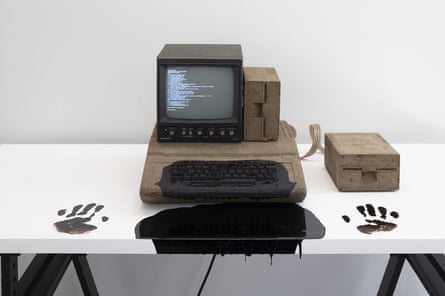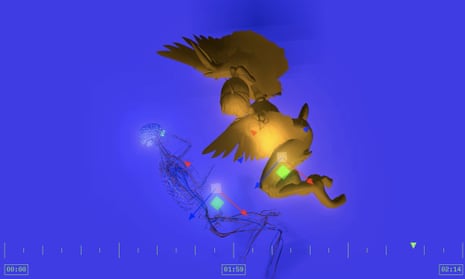As technology takes an ever more significant role in shaping how we develop and embody our identities, the Whitney presents Refigured, a collection of five installations by artists using digital art to probe intersections of ourselves and our machines.
“I want to create language for a calibration point for where we are in regard to our bodies and technology,” said artist Rachel Rossin, reflecting on her piece The Maw Of, a transmedia work that is spread out across a video screen and a QR code that can activate the artwork on visitors’ mobile devices. As Rossin put it, The Maw Of seeks to “address the black boxes of our bodies and technology”.
Over a soundtrack of new age-y music, Rossin’s animation blends together visceral images of the human nervous system, dismantled code from the Whitney’s own website, imagery that looks stripped from a military campaign, and a central manga figure. The piece’s QR code adds elements from the animation into the camera of a mobile device, while adding other artistic effects and bits of enigmatic text like “into the void” and “why run from disappointment”.
The Maw Of’s layers implicate an idea central to Rossin’s output – how technology has moved away from being a mere tool of humanity and more toward something that blends right into our consciousness. “The idea of technology that we’ve inherited frames it as something that we add to ourselves. And now, what technology actually is becoming is that you begin to find peripherals for our cognition, peripherals for our psychology.”

Echoing Rossin’s concern with how technology has moved steadily into the heart of our identities, the title of American Artist’s the Mother of All Demos III references the epochal moment on 9 December 1968, when Douglas Engelbart and William English introduced the computer mouse and graphic user interface, opening the way for computers to become central to our way of life. Rather than depict the machine that Engelbart and English used for their world-changing demo, Artist instead offers an Apple II computer, debuted in 1977 and part of a wave of home computers that fueled a revolution.
In Mother of All Demos III, Artist, who legally changed their name in order to protect their anonymity and further their artistic ideas around Blackness, labor and visibility, shows a dirt-encrusted Apple II computer disfigured by black asphalt that renders the keyboard inaccessible. That same asphalt also depicts suggestive handprints on either side of the keyboard, making the installation look something like a crime scene.
In the work, the subdued blackness of the Apple II computer terminal – which, as computers have changed, has slowly given way to white-dominated monitors – is juxtaposed with the seeping, gooey asphalt, which seems to suggest that Blackness will not so easily be contained. The whole piece has something of the feel of an archetypical, Promethean moment when things changed forever.
Just as Artist channels age-old tropes through cutting-edge technological developments, so do the other artists on display here, making a major through line of Refigured. For instance, Rossin discussed how she drew from the golem myth to conceptualize how the digital realm breathes life into something inanimate. “What I wanted to make is something that feels like more of a golem myth, the nervous system being projected into this hyperreal space that’s always on in an illusory way.”

Another who reimagined a cultural myth via technology is the Iranian-Kurdish artist Morehshin Allahyari, who drew inspiration for her work from the story of the laughing snake, which she construed as a story about women reclaiming agency. The myth, attributed to a medieval Arabic volume titled The Book of Wonders, tells of a marauding snake that is finally conquered by way of men who use a mirror to turn the snake’s laughter against herself.
For her project, Allahyari turns the parable of the snake into a hypertext narrative, blending elements of Iranian feminism, her personal coming of age, power and autonomy. “I turn around [the snake’s] laughter and death as a position of power, rather than a position of weakness. Her destruction of her own body is her way of taking control of her body agency; her destruction of her body is her way of taking back her image. I connect this story to street harassment, sexual desire, relationship to body and body agency, starting from my personal experiences of growing up in Iran and to then more of the collective experiences, and expanding that to these imaginative stories where I imagine alternative futures for our relationship with our bodies.”
Viewers traverse Allahyari’s hypertext by way of highlighted words, while various evocative black-and-white animations and ethereal sounds create a mysterious ambiance. The artist shares her own experiences with various forms of sexism and misogyny, from street harassment and various degrees of sexual violation to institutionalized violence against women. The hypertext is at once complex and maze-like, making it easy to feel absorbed by the lasting and visceral power of Allahyari’s words. The Laughing Snake also implicates questions of westernized feminism’s limited scope when confronted with instances of sexual abuse and systemic sexism that occur in a nation like Iran.
Refigured is a compelling exhibition that manages to bring a wealth of diversity of identities, approaches and media with just five pieces. The depth and complexity of each work in Refigured makes it a show in which one can linger, each of these five works proving absorbing and thought-provoking in its own way. It also feels fresh, a reflection of the Whitney going out and finding artists who are newer to its space, and bringing kinds of art less frequently seen there. “Showing at the Whitney is a dream that I’ve had since I was very young,” said Rossin. “I grew up outside of the art world, so I looked at these spaces as imposing. It’s exciting to be showing there.”
Refigured is on show at the Whitney Museum of American Art in New York from 3 March to July
